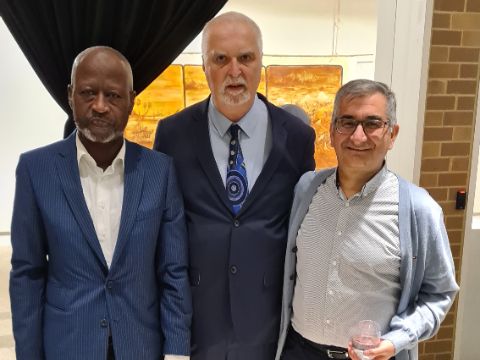- A Charles Sturt University Islamic academic has explored the rich history of Islam in Australia through the ages in his presentation at a multicultural exhibition in Melbourne
- He examined the very long history of Islam in Australia and Muslim attachment to Australia, developed through migratory waves
- ‘Muslim Australianness and Muslimness in an Australian way’ as Muslims also joined non-Muslims and together built a cohesive multicultural society
A Charles Sturt University Islamic history expert has delivered a presentation in Melbourne as part of a multicultural exhibition showcasing the historic interaction between Australian First Nations people and the Makassans of Indonesia.
 Dr
Dzavid Haveric (at left, and above centre) Adjunct Research Fellow in the Charles Sturt Centre of Islamic Studies and
Civilisation spoke at the Wind Talks:
Yolnu-Makassan Encounters (Barrak-Dhimmurru|Warrak-Timborok) exhibition at Broadmeadows Town Hall in Melbourne, Victoria.
Dr
Dzavid Haveric (at left, and above centre) Adjunct Research Fellow in the Charles Sturt Centre of Islamic Studies and
Civilisation spoke at the Wind Talks:
Yolnu-Makassan Encounters (Barrak-Dhimmurru|Warrak-Timborok) exhibition at Broadmeadows Town Hall in Melbourne, Victoria.
Barrak’ in Yolŋu language and ‘Warak’ in Makassar language means Northern wind. ‘Dhimmurru’ in Yolŋu and ‘Timborok’ in Makassar refers to the Southern wind.
This exhibition shows that Makassan fishermen and traders were peaceful visitors and temporary settlers who had fruitful interactions with the Indigenous population, especially the Yolngu people.
There is evidence in Aboriginal songs, rituals, and storytelling referring to the Makassans arrivals.
“These encounters, friendship and trading partnership with Makassans were regarded by some contemporary Aboriginals as ‘the golden age of civilisation’, Dr Haveric said.
 His lecture drew on archival data and photographs to explore the many lesser-known historical facts that reveal the diversity of Australian Muslim experiences and their contribution to Australian society and history.
His lecture drew on archival data and photographs to explore the many lesser-known historical facts that reveal the diversity of Australian Muslim experiences and their contribution to Australian society and history.
“All the subjects I addressed clarify the very long history of Islam in Australia and Muslim attachment to Australia, developed through migratory waves,” Dr Haveric said.
Dr Haveric said Muslim migrants of various ethnic backgrounds played an important role in the building of the Australian nation.
“My presentation of the fascinating social-historical context demonstrated the riches of Islamic and Muslim history as part of a much broader Australian history in times of different social policies,” he said.
“Muslim migrants found Islam in Australia more pluralistic and sophisticated than in their countries of origin, because in Australia they met Muslims from many different ethnic, racial, cultural, sectarian and linguistic backgrounds.
“Over time, Islam underwent a dual process in Australia: one of universalisation (which means Muslims retained core Islamic principles) and another of localisation (which means Muslims left behind tribal tradition, local costumes and some spiritual reflections) by adapting the universal Islamic message to a new environment.
Another aspect was cross-fertilisation, which is Muslims of diverse backgrounds mixed with each other in a new environment.
Dr Haveric emphasised ‘Muslim Australianness and Muslimness in an Australian way’ as Muslims also joined non-Muslims and together built a cohesive multicultural society.
“They became an integral part of their new home’s social landscape,” he said. “As such, Muslims built their home ethos accommodated in a predominantly Christian, also multi-faith and secular society. They are proud of being Australians.
“By building the bridges with non-Muslims, and by exchanging ideas and experiences with them, Muslims in Australia are contributing to a never-ending conversation of humanity.”
As part of his lecture Dr Haveric noted, “In 1971, the first book on Islamic doctrine was published in Australia focusing on Islamic social and legal aspects, titled Outline of Islamic Doctrine”.
He said this forgotten masterpiece explores social virtues such as: respect of law and order, appreciation of pluralities within Islam, love and compassion, kindness and forgiveness, modesty and decency, truthfulness and honesty, faithfulness and loyalty, brotherhood and fraternal solidarity, justice and equity, benevolence and charity, broadmindedness and tolerance, safety and security, mutual cooperation and social cohesion with non-Muslims.






Social
Explore the world of social